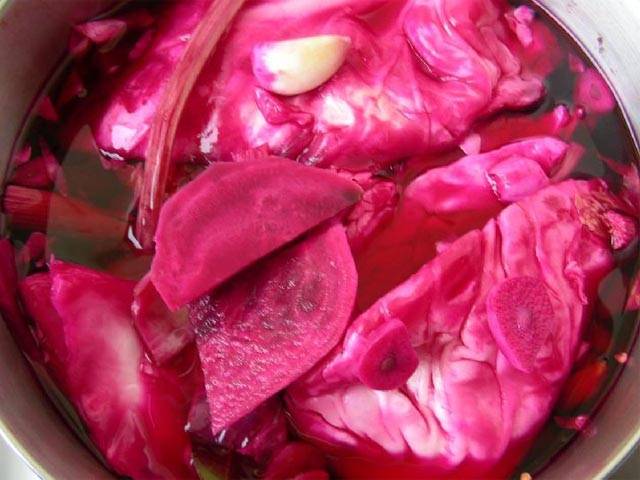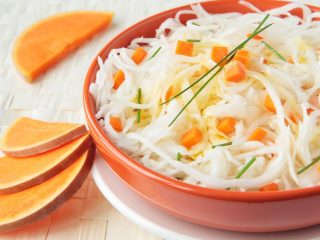Among the numerous cabbage preparations, pickled dishes clearly occupy a leading position in the modern world. And all thanks to the speed of execution of these dishes, judge for yourself; you can try fully prepared cabbage just a day after it is prepared. Of course, it cannot be compared with sauerkraut, which only needs several weeks for good fermentation, and according to some recipes even more than a month. Many people also like the taste of pickled cabbage - spicy, spicy or, conversely, sweet and sour or even sickly sweet. Of course, thanks to various combinations of sugar and acetic acid, you can get a whole palette of flavors, which is much more difficult to do in the process of regular sauerkraut.
Well, pickled cabbage with beet, in general, has been a hit for many seasons in a row. After all, beetroot, that is, beets, colors the finished dish in a fabulously beautiful crimson hue. And thanks to different ways of cutting cabbage, you can further diversify the range of ready-made snacks you get.
Cabbage "Pelustka"
Despite the fact that now in almost any store you can find jars of this popular preparation, it is much nicer and healthier to prepare delicious pickled cabbage with beet with your own hands. By the way, all this will cost you much less, especially if you have your own garden with vegetables.
Indeed, cabbage leaves, colored with beet juice, resemble the petals of some fantastic flower. If you arrange them beautifully on a platter, then this appetizer can become an inimitable decoration for your holiday table.
And it’s not at all difficult to prepare it, you just need to find:
- Cabbage – 2 kg;
- Carrots – 2 pcs;
- Beets – 1 piece;
- Garlic – 4-5 cloves.
The prepared head of cabbage is freed from the top leaves and cut into two, three or even four parts, so that it is then convenient to cut out the stalk area from it. After which each piece of cabbage is cut into another 5-6 serving pieces.
Beets and carrots can be chopped into strips, but many people cut these vegetables into slices or cubes - later such large pieces can be enjoyed separately in pickled form.
The garlic is peeled, divided into cloves and each clove is cut into another 3-4 parts.
This recipe for pickled cabbage involves laying vegetables in layers and it is more convenient to do this in a wide enamel pan. However, if you can carefully place the vegetables in layers in a glass jar, then nothing should stop you from doing this.
Spices in the form of garlic, allspice and black peppercorns in an amount of about 10 pieces and several bay leaves are placed at the very bottom. Then several pieces of cabbage are placed, carrots are placed on top, then beets, then cabbage again and so on. At the very top there should be a layer of beets.Vegetables are slightly compacted when stacked, but not much.
The marinade is prepared in the most traditional way: in a liter of water, 70 grams of salt and 100-150 grams of sugar are heated to a boil. After boiling, 100 grams of vinegar is poured into the marinade.
If you are in a hurry to try the prepared cabbage as soon as possible, you can pour the hot marinade over the layered vegetables. But according to the recipe, it is better to cool it first and only then pour it. The process will be slow, but the taste of the finished cabbage will be much richer and more intense. Leave the dish at room temperature for 2-3 days, and then it is recommended to put it in a cool place. Already on the third day you can taste the cabbage, although it will acquire a real rich taste in about a week.
Georgian recipe
A recipe for pickled cabbage using beets has become very popular lately. in Gurian or in Georgian. In general, in its essence it is not much different from the same cabbage, only in that it uses a much larger number of additives. First of all, these are a variety of aromatic herbs and spices. The Georgian recipe is also spicy due to the introduction of hot pepper into the composition.
For the same amount of vegetables as in the first recipe, you need to add from 1 to 3 pods of hot chili pepper. It is usually washed, cleaned of the seed chambers and cut into circles or strips.Some even add whole pepper pods to the marinade without removing the seeds, but in this case the cabbage may be too spicy for a taste unaccustomed to pepper.
The most commonly used herbs are one small bunch each of celery, parsley, cilantro, basil, tarragon and thyme. If you don’t find some herb, don’t be upset - you can either do without it completely or use it in the form of a dried spice.
For spices, additionally use a few pieces of cloves, a teaspoon of coriander seeds and the same amount of cumin.
The rest of the manufacturing process Georgian cabbage no different from the above recipe. Another thing is that Georgians rarely use table vinegar. Usually they simply ferment all the layered vegetables with seasonings in warm brine. And after 5 days, cabbage prepared in this way can be tasted.
If you want to prepare pickled cabbage according to this recipe, then you can use any natural vinegar: apple or grape.
Mediterranean recipe
Among the many recipes for pickled cabbage with beets, I especially want to highlight this one, which originates from the Mediterranean countries and is distinguished by a special, spicy aroma and unique taste, thanks to the many interesting ingredients used in it. Lovers of everything unusual should definitely try it, especially since all the ingredients for it are quite easy to find.
Cabbage, carrots, beets and garlic are taken in the same quantities as indicated in the above recipe.But then the fun begins - you will need to additionally find:
- Juniper berries (you can use dry ones from the pharmacy) – 5 pieces;
- Sweet bell pepper – 2 pieces, it’s good if they are of different colors, for example, red and yellow;
- Ground hot pepper - half a teaspoon;
- Mustard seeds – 1 teaspoon;
- Cloves – 4-5 pieces;
- Nutmeg and cumin - half a teaspoon each;
- Allspice, black pepper and bay leaf - according to the first recipe.
Carrots and beets are cut into any shape according to your taste, garlic is crushed using a crusher. Peppers of both varieties are cut into small rings.
All vegetables are carefully mixed together in a large separate container and then placed in jars. All spices are mixed separately. You must first put a mixture of spices on the bottom of the jars, and then just pack the vegetables tightly.
The marinade differs only in the use of olive oil, traditional for Mediterranean countries. For 1 liter of water, take 1 glass of oil, half a glass of apple cider vinegar, 100 g of sugar and 60 g of purified sea salt. All this, except vinegar, is heated to a boil and boiled for 5-7 minutes. After that, vinegar is added and all the vegetables are poured with hot marinade. The jars are covered with plastic lids and left at room temperature for a couple of days. Then the workpiece must be transferred to the cold.
If you have never made pickled cabbage with beets before, be sure to try these recipes. But even if you are already familiar with this dish, you will probably find something new for yourself in the above recipes.And they will give you an incentive to improve yourself in cooking.


















